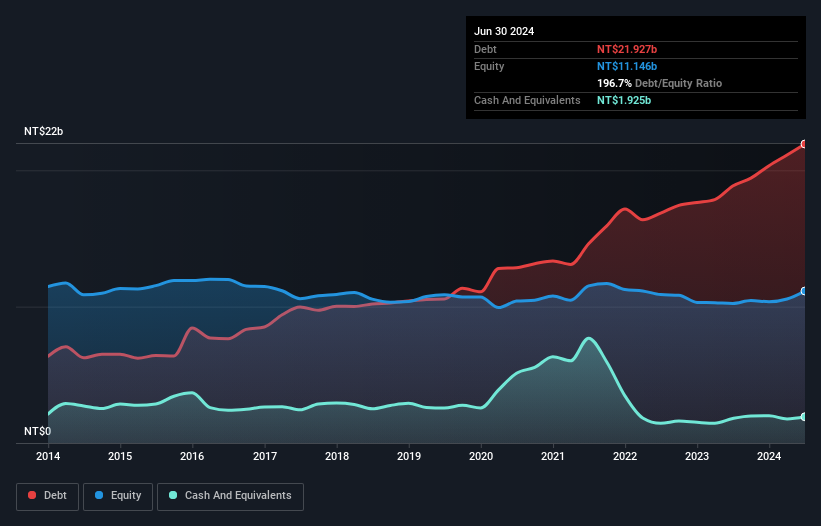Warren Buffett famously said, 'Volatility is far from synonymous with risk.' So it seems the smart money knows that debt - which is usually involved in bankruptcies - is a very important factor, when you assess how risky a company is. Importantly, Nankang Rubber Tire Corp.,Ltd. (TWSE:2101) does carry debt. But is this debt a concern to shareholders?
When Is Debt A Problem?
Debt assists a business until the business has trouble paying it off, either with new capital or with free cash flow. In the worst case scenario, a company can go bankrupt if it cannot pay its creditors. However, a more frequent (but still costly) occurrence is where a company must issue shares at bargain-basement prices, permanently diluting shareholders, just to shore up its balance sheet. By replacing dilution, though, debt can be an extremely good tool for businesses that need capital to invest in growth at high rates of return. The first thing to do when considering how much debt a business uses is to look at its cash and debt together.
Check out our latest analysis for Nankang Rubber TireLtd
What Is Nankang Rubber TireLtd's Net Debt?
As you can see below, at the end of June 2024, Nankang Rubber TireLtd had NT$21.9b of debt, up from NT$18.8b a year ago. Click the image for more detail. However, it does have NT$1.92b in cash offsetting this, leading to net debt of about NT$20.0b.

How Strong Is Nankang Rubber TireLtd's Balance Sheet?
Zooming in on the latest balance sheet data, we can see that Nankang Rubber TireLtd had liabilities of NT$20.5b due within 12 months and liabilities of NT$14.5b due beyond that. On the other hand, it had cash of NT$1.92b and NT$1.91b worth of receivables due within a year. So its liabilities outweigh the sum of its cash and (near-term) receivables by NT$31.2b.
This is a mountain of leverage relative to its market capitalization of NT$39.4b. Should its lenders demand that it shore up the balance sheet, shareholders would likely face severe dilution.
In order to size up a company's debt relative to its earnings, we calculate its net debt divided by its earnings before interest, tax, depreciation, and amortization (EBITDA) and its earnings before interest and tax (EBIT) divided by its interest expense (its interest cover). The advantage of this approach is that we take into account both the absolute quantum of debt (with net debt to EBITDA) and the actual interest expenses associated with that debt (with its interest cover ratio).
Nankang Rubber TireLtd has a rather high debt to EBITDA ratio of 13.2 which suggests a meaningful debt load. But the good news is that it boasts fairly comforting interest cover of 5.8 times, suggesting it can responsibly service its obligations. Notably, Nankang Rubber TireLtd made a loss at the EBIT level, last year, but improved that to positive EBIT of NT$825m in the last twelve months. When analysing debt levels, the balance sheet is the obvious place to start. But it is Nankang Rubber TireLtd's earnings that will influence how the balance sheet holds up in the future. So when considering debt, it's definitely worth looking at the earnings trend. Click here for an interactive snapshot.
Finally, a business needs free cash flow to pay off debt; accounting profits just don't cut it. So it is important to check how much of its earnings before interest and tax (EBIT) converts to actual free cash flow. During the last year, Nankang Rubber TireLtd burned a lot of cash. While investors are no doubt expecting a reversal of that situation in due course, it clearly does mean its use of debt is more risky.
Our View
On the face of it, Nankang Rubber TireLtd's net debt to EBITDA left us tentative about the stock, and its conversion of EBIT to free cash flow was no more enticing than the one empty restaurant on the busiest night of the year. Having said that, its ability to cover its interest expense with its EBIT isn't such a worry. We're quite clear that we consider Nankang Rubber TireLtd to be really rather risky, as a result of its balance sheet health. So we're almost as wary of this stock as a hungry kitten is about falling into its owner's fish pond: once bitten, twice shy, as they say. The balance sheet is clearly the area to focus on when you are analysing debt. But ultimately, every company can contain risks that exist outside of the balance sheet. These risks can be hard to spot. Every company has them, and we've spotted 2 warning signs for Nankang Rubber TireLtd you should know about.
Of course, if you're the type of investor who prefers buying stocks without the burden of debt, then don't hesitate to discover our exclusive list of net cash growth stocks, today.
Valuation is complex, but we're here to simplify it.
Discover if Nankang Rubber TireLtd might be undervalued or overvalued with our detailed analysis, featuring fair value estimates, potential risks, dividends, insider trades, and its financial condition.
Access Free AnalysisHave feedback on this article? Concerned about the content? Get in touch with us directly. Alternatively, email editorial-team (at) simplywallst.com.
This article by Simply Wall St is general in nature. We provide commentary based on historical data and analyst forecasts only using an unbiased methodology and our articles are not intended to be financial advice. It does not constitute a recommendation to buy or sell any stock, and does not take account of your objectives, or your financial situation. We aim to bring you long-term focused analysis driven by fundamental data. Note that our analysis may not factor in the latest price-sensitive company announcements or qualitative material. Simply Wall St has no position in any stocks mentioned.
About TWSE:2101
Nankang Rubber TireLtd
Manufactures and sells tires and various rubber supplies in Taiwan, China, America, Europe, Asia, and internationally.
Mediocre balance sheet not a dividend payer.
Similar Companies
Market Insights
Community Narratives



